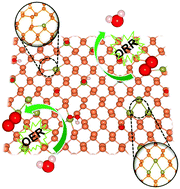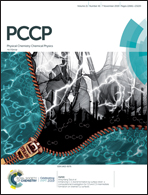Synergy of tellurium and defects in control of activity of phosphorene for oxygen evolution and reduction reactions†
Abstract
Developing low-cost and metal-free electrocatalysts for the oxygen reduction reaction (ORR) and oxygen evolution reaction (OER) is desirable for renewable energy technologies. Recent experiments show that tellurium (Te) atoms can be effectively doped into black phosphorus (BP) nanosheets, and they greatly improve its OER catalytic performance. However, the specific active sites and microscopic configurations in the atomic-scale are still ambiguous. Here, we show that the doped Te atoms prefer to bond with each other to form clusters in phosphorene and they can be further stabilized by various intrinsic defects (Stone–Wales, single vacancy defects and zigzag nanoribbon). Benefiting from the reduced binding strength of O*, Te dopants and intrinsic defects synergistically boost the catalytic activity of phosphorene. The best OER catalytic activity could be realized in the cluster SW2-Te1p (Stone–Wales defect decorated by one Te atom). For ORR, the cluster Pri-Te3p (pristine phosphorene decorated by three Te atoms) exhibits optimal catalytic activity. Calculated ORR/OER potential gaps indicate that the SW2-Te3p cluster most likely acts as the efficient bifunctional catalytic site for both ORR and OER.



 Please wait while we load your content...
Please wait while we load your content...